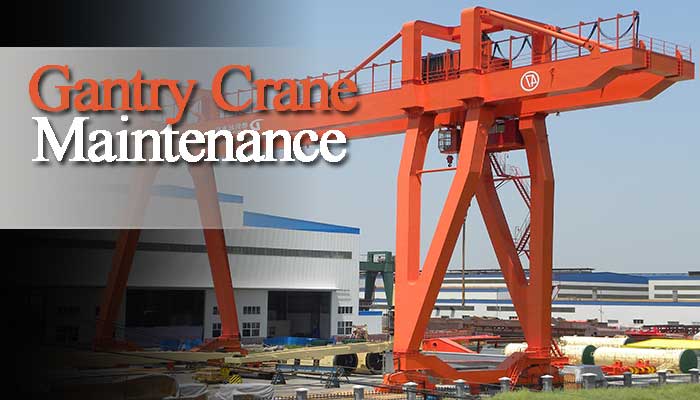
Gantry Crane Maintenance & Crane Maintenance Procedures
Importance of regular gantry crane maintenance
When it comes to your gantry crane, regular maintenance and inspections are required, just like any other mechanical component. Any overhead crane operation comes with its own set of risks. Because they are meant to transport huge loads, regular maintenance and inspections are required to guarantee that they operate safely and reliably.
Dependability Equals Safety
Anyone who operates or works near a gantry crane relies on the crane's safety and dependability for their safety. Daily inspections and routine preventive maintenance will reveal any potential hazards with the crane, allowing them to be addressed before they become a danger.
Protecting Your Investment
Your crane is a significant financial investment. You'll want to safeguard that investment against wear and tear, as well as the possibility of downtime due to repairs or malfunctions. Regular inspections are critical not just for finding possible problems, but also for assuring the safety of operators and anybody else working nearby. Inspections and routine preventative maintenance allow problems to be identified before they become huge and cause more serious problems in the future.
Protecting Your Employees
OSHA regulations require that all overhead cranes be inspected on a daily basis, according to predetermined checklists and schedules. If someone is hurt as a result of an OSHA violation, not only will your business suffer, but you could also face criminal penalties, fines, and jail time.
The daily inspection must be completed by the operator each day before to use at the start of a shift, according to OSHA. The operator must be educated and authorized to operate the safety equipment, and it must be present and in use at all times. It's critical to construct a safety checklist as part of a complete maintenance plan, and to cease using the crane immediately if any noises or strange movements are observed.
OSHA Mandates Maintenance Compliance
The crane manufacturer usually specifies preventive maintenance. These are intended to not only keep the crane in good working order, but also to extend its longevity. OSHA requires that the crane's owner implement a maintenance program that complies with OEM standards in addition to the manufacturer's maintenance specifications.
Safe Equipment
Daily checks should always be the first step in maintenance. These will reveal issues that must be addressed before they become risks. Early detection and correction of minor issues helps to avoid costly and perhaps dangerous situations. The owner and operator can guarantee that the equipment is safe to use by arranging a daily inspection.
Equipment Longevity
Regular inspection and maintenance, in addition to safety considerations, guarantee that your equipment lasts as long as possible. The frequent lifting of varied weights can take its toll on a crane and expose everyone to risky situations, especially when dealing with high loads. Your crane will provide safe and dependable service if it is properly maintained.
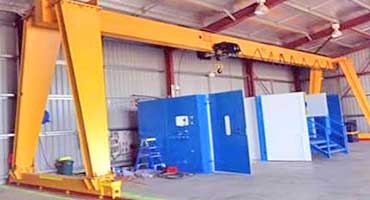
Single girder gantry crane
Single girder gantry crane specifications: Capacity: 1ton-20ton, Span Length: 8~30m, Working Class: A3, A4. Ask for single girder gantry crane price.
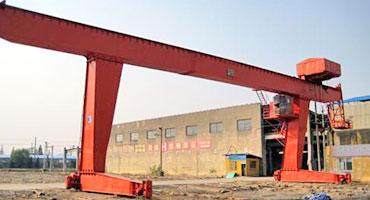
L leg single girder gantry crane
L types gantry crane specifications: Capacity 5ton -32ton, Span Length: 18~35m, Working Class: A5, A6.Ask for l leg single beam gantry crane price.
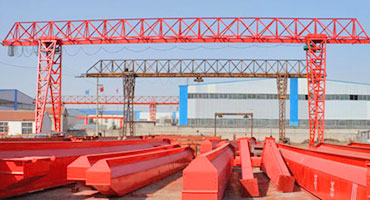
Truss girder gantry crane
Truss gantry crane specifications: Capacity: 1 ton -50 ton, Span Length: 12~35m, Working Class: A5, A6. Ask for truss gantry crane price.
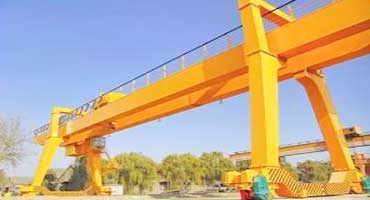
Double girder gantry crane
Double girder gantry crane specifications: Capacity: 5 ton - 500 ton, Span Length: 12~35m, Working Class: A5, A6.Ask for double girder gantry crane price.
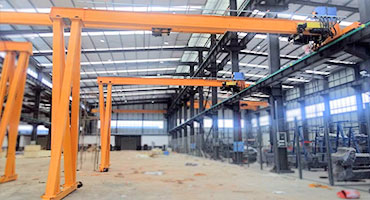
Semi gantry crane
Semi-gantry crane specifications: Capacity: 2 ton- 10 ton, Span Length: 8~20m, Working Class: A3, A4.Ask for semi-gantry crane price.
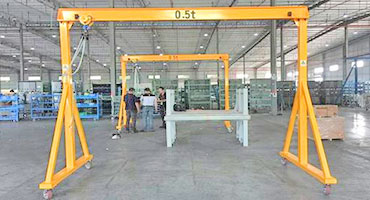
Portable gantry crane
Portable gantry crane specifications: Capacity:0.25 ton -10ton, Span length: 2~16m,Lifting height : 2~12m, Working class : A2.Ask for small gantry crane price.
Gantry crane Maintenance Procedures
Gantry crane maintenance is important to ensure the safety of Gantry crane machines. Regular Gantry crane maintenance is required to prevent Gantry crane accidents. How to maintain your Gantry crane machines? Generally, the Gantry crane maintenance should be conducted by designated persons who are professional and experienced. Dongqi Gantry crane is able to provide your professional Gantry crane maintenance services with efficiency. In the following, the Gantry crane maintenance procedures are presented for your sake.
Gantry crane maintenance repair cycle:- A period of one to three months
- Time of four to eight hours
Gantry crane maintenance repair contents:
- The cost of replacing the worn wire rope had reached its maximum. To guarantee proper lubrication, the casting lane, lane rope front will be replaced once every six months.
- The replacement of damaged pins and screws.
- The brake shoe needed to be replaced because it had reached its wear limit (50 percent of original thickness).
- Damaged hooks, shields, and pulleys must be replaced, and hooks must be inspected once a year.
- The installation's adjustment element, as well as the deviation induced by use and the elimination of concealed threats.
- The defective safety device was replaced.
- Motor brushes, controller, and contactor contact burns should all be repaired or replaced.
- Adjustments should be limited.
- The motor was replaced.
- I took over the inspection of gear wear and replaced the wrecked pieces. To guarantee proper lubrication, drive the casting lifting mechanism, coupling, and dismantle once every three months.
- Examine the reel.
- Change the primary driving gear (traveling crane), clean the oil, or replace it.
- Refueling the lubrication points to guarantee proper lubrication.
- Deal with the issue that is frequently discovered in the inspection point.
- Remove the brake and replace it.
Maintenance standard:

Open winch trolley- Box girder gantry crane parts and components

Main girder- Box girder gantry crane parts and components
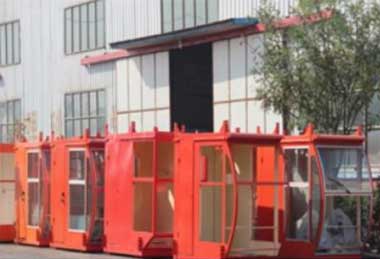
Gantry cabin - Box girder gantry crane parts and components
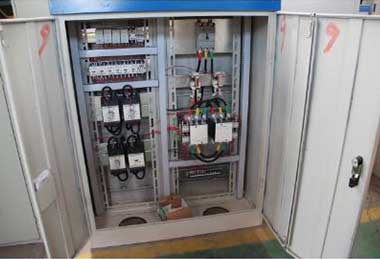
Siemens contol-unit- Box girder gantry crane parts and components
Brakes:
- If the pin has lost more than 5% of its original diameter or has become oval, it should be replaced.
- When a lifting mechanism employs double brakes, each brake must have a safety factor of 1.25.
- Make that the side wheel and brake shoe gap are both the same.
- The tilt, unbalance brake shoe, and brake wheel brake must not exceed the width of 1/1000 when the brake is released.
- The relative inaccuracy between the brake wheel center and the center brake shoe cannot exceed 3mm.
Brake drum:
- Outer roughness should not be less than 3.2, with a 60 percent grind groove surface area and a depth of 3mm.
- The temperature of the brake wheel's surface does not surpass 200 degrees Celsius.
- The face run out of the brake wheel after assembly must not exceed the standard.
Wire rope:
- Although not damaged, rope surface wear reaches 40%, casting, blast furnace traffic by 20%, and it should be destroyed.
- Surface degradation and broken wires should necessitate fewer resources.
- When a rope strand breaks, the entire rope strand should be trashed.
- When the hook is in the lowest position, tighten the wire rope on the drum plate completely, leaving at least 2 to 3 turns on the reel.
- To meet the original design requirements, new wire rope wire rope must validate the specifications and mechanical properties.
Gantry crane maintenance on reducer:
- Between the shaft needle and the two etched lines, the deceleration oil surface should be maintained.
- There must be no loose screws in the feet bolts or joints.
- There are no visible leaks.
- When the cap is tightened, the surface space between the gearbox and the cap is less than 0.03mm.
- Tooth wear of 4,5 Gantry crane hoisting mechanism gear is up to 15% of the thickness, with a 10% hoist; other agencies' gear wear is up to 25% of the thickness..
Gantry crane maintenance on pulley
- When the wall thickness of the pulley sheaves reaches 10%, they should be scrapped.
- Pulley ropes with a bottom wear rate of more than 25% should be destroyed.
- Scrape any cracked or broken rim sections.
- Should be scrapped if the relative rotation between the pulley shaft hole and the bearing outer ring is too high.
- Pulleys should rotate freely without jamming.
Gantry crane maintenance on the teeth took over
- Once every three months, lubricate the gear coupling.
- Operating agency can gear up to 20% more than the amount of wear, and the lifting mechanism can lift up to 10% more.
Gantry crane maintenance on hook:
- If the real opening of the hook is larger than the nominal opening, 15% of the hook should be destroyed.
- Steel traffic up to 5% should be terminated when hooks problematic part wear reaches a height of 10%.
- Hooks that have developed a permanent distortion should be destroyed or replaced.
- If major fissures are discovered during a once-a-year inspection, the structure should be demolished.
Makes the Best Value of Your Gantry crane
Full Gantry crane Services
Hoist & Gantry crane Turn-Key Project Services - Consultation, design, fabrication, Installations. Preventative Maintenance. Renew, & Upgrades.
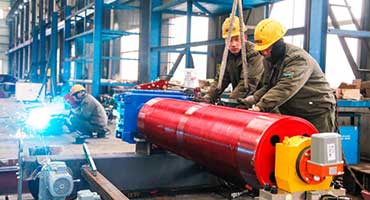
Free consultation on crane design
Overhead travelling crane design, overall crane project design, processing design, excellent technical and economical crane purchasing plan design are all available from our pre-sale technical support.
Gantry crane after sale services
Gantry crane after-sale services are the very important part of overhead travelling buying. Superior after sale crane services will ensure the safety and reliability of your crane in a long run and make the best value out of your investment.
Gantry crane on-time delivery
Gantry crane for sale to South Africa,Malaysia, United Arab Emirates ,Singapore ,Canada ,Saudi Arabia ,Philippines,Pakistan, Australia, United States ,Thailand, Indonesia, Brazil, etc.
Gantry crane installation & commissioning
Gantry crane installation and commissioning services is one of our important after sale services which will help our clients to install the overhead crane, gantry crane, jib cranes and various process designed industrial cranes correctly and safely to ensure the optimal overhead crane operation operation conditions and efficiency to make the best value out of your investment
Gantry crane training
Gantry crane training services of us are specialized after sale crane services which is exclusively to valuable clients and customers to qualify your staff, improve crane safety &efficiency, maximize your uptime and lower crane maintenance cost to make the best value out of your overhead travelling crane investment in a long run.
Gantry crane inspection & maintenance
Gantry crane inspection and maintenance are effective way to improve the safety and productivity of your overhead travelling cranes, gantry cranes, and jib cranes through a series of preventive inspections, routine maintenance, and corrective maintenance, and modernization service. A lifetime care crane services are available for you.
Gantry crane upgradation & refurbishment1
Gantry crane upgrade and refurbishment is one of the most economical way to renew your overhead travelling crane with new and advanced crane features, extend your crane service life and enhance crane safety.
Gantry crane parts supply
Various types of crane spare parts and components, crane kits, and type of below-the-hook devices supply, etc. If you need crane, hoist or crane parts, Please feel free to contact us. We will reply you in 12 hours.



